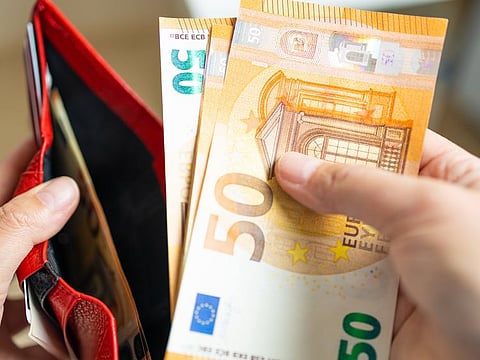UAE: Shopping online or overseas? Why you can now spend more euros than before
With euro value plunging against the US dollar, why you'll get more when you shop in euros

Dubai: The euro and the US dollar reached parity earlier last week, meaning one dollar could buy one euro when exchanging foreign currencies.
For over two decades, it took more than one US dollar to purchase one euro. Just a year ago it took about 1.2 US dollars to purchase one euro.
In the last year, the euro has lost nearly a quarter of its value versus the US dollar. The slide in value for the euro zone’s shared currency now puts it at a level we haven’t seen in nearly 12 years.
Who benefits when the euro drops?
But who benefits when a currency like the euro drops? Could tourists play the role of potential beneficiaries or is it online shoppers? Let’s first understand how this can be taken advantage of.
When a currency like the dollar appreciates, it’s able to buy more goods that’s priced in currencies outside country borders. When a currency loses value, it isn’t able to buy as much.
In this case, the dollar’s gain relative to the euro means that greenback-based consumers have more purchasing power to buy things denominated in euros.
Illustration on how shoppers can take advantage of a weaker euro
Let’s say a handbag in Paris costs 300 euros. It would have cost you around $415 (Dh1,524) to pay that a year ago, when euros cost $1.385. That same 300 euro bag would only cost $318 (Dh1,168) today with euros costing $1.06. That’s about Dh350 in savings for a UAE shopper transacting in US dollars.
But that’s in theory, what’s the reality?
The price levels you’re seeing when monitoring real-time exchange rates won’t necessarily be the price you’ll get when you spend euros. It all depends on how you go about buying euros.
For instance, according to currency exchange giant Travelex, a euro costs $1.1969 (Dh4.40), despite the current interbank market rates of $1.06. That means it costs 13 per cent more to buy your currency there than what’s indicated in the market.
So while you can exchange currencies at kiosks or banks, and even though they represent an efficient way to get your hands on cash immediately, just be prepared to pay more.
Any other cost-effective options?
Other options can be more cost effective. Many travel experts will advise using credit cards to do the bulk of your spending when euro is in decline, and for good reason.
Those looking to transact in euros or other dollar-pegged currencies like the UAE dirham will be benefittedMona Kahn, forex analyst
“The rates that banks and credit card companies use in converting foreign currency charges to dollars is much more favourable, but there are also fees to be aware of,” explained UAE-based forex analyst Mona Kahn, who previously worked as a travel consultant in the UK.
“All of these factors affect what ultimately shows up on your credit card statement after you’ve spent money in a foreign currency.”
Fees to factor in when transacting abroad
Most credit card brands charge an average of about 3 per cent foreign transaction fee for any purchases made outside the UAE, which is on top of whatever the prevailing exchange rate is for converting your purchase to US dollars.
Another option involves using your bank-issued debit card for purchases, or withdrawing money from a bank ATM when abroad. However, this still involves the debit card’s foreign transaction fees.
But with most credit cards and bank-issued debit cards, you can expect a transparent exchange rate that’s close to current market levels, along with a foreign transaction fee.
What if I withdraw money from a local bank ATM when travelling abroad?
Withdrawing money from a local bank ATM is also a more efficient option, though you will be assessed fees by not only the foreign bank, but possibly your own financial institution as well. Other banks and credit card payment networks charge their own schedule of fees, so it’s worth investigating which options are best given what’s in your wallet, or what’s appropriate for your individual financial situation.
Could the euro drop further against the US dollar?
This euro’s retreat into the US dollar could become even more extreme if Europe and the US enters a recession, warned George Saravelos, global co-head of forex research at Deutsche Bank in UK, in a note last week.
A situation where the euro is trading below the US dollar at a range of $0.95 to $0.97 could “well be reached”, wrote Saravelos, “…if both Europe and the US find themselves slip-sliding in to a (deeper) recession in the third quarter while the US is still hiking rates”.
“That's good news for Americans with plans to visit Europe this summer but could spell bad news for economic global stability.”
Bottom line?
What happens on an economic scale when the euro weakens? On a broader level, the euro’s weakness against the dollar helps European exporters make their products more competitive and earn profits.
European businesses that sell their wares abroad might find the weaker currency makes their exports more appealing, because the buyer’s currency will be more valuable by comparison. “More significantly, it comes as a relief to US travellers to Europe, reducing the cost of their trips,” added Kahn.
“Those looking to transact in euros or other dollar-pegged currencies like the UAE dirham will be benefitted given that they will get comparatively more value for their money compared to a few months earlier.”
In other words, those with the US dollar or currencies pegged to it, has greater spending power when visiting such euro zone destinations as France, Germany, Spain, Italy and Greece.
Sign up for the Daily Briefing
Get the latest news and updates straight to your inbox






